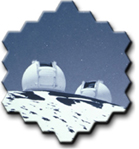LGSAO Observer's Checklist
A. Prior to the run
- Formulate an observing plan. Please consider each of the issues below
prior to the science planning teleconference.
- Target scientific priority.
- TT reference R magnitude.
- Elevation constraints (20° in east, 36.8° in west,
and see pupil rotation constraints
page for zenith constraints).
- Is the TT reference extended or binary?
- Target identification strategy (innitial images in wide camera, etc.)
- Observing wavelength.
- Is a certain PA or VA required?
- Observing scripts to be used (bxyn, manual dither, custom scripts,
etc.)
- Minimum total integration time required.
- Required calibrations (twilight, photometric, sky frames,
astrometric, etc.)
- Create a prioritized target list.
- The target list must follow the LGSAO format described
here.
- Software to assist in the identification of TT reference stars
can be downloaded from the software distribution
page.
- For off-axis observations (r>30"): is the TT reference star in the
field of regards of the tip-tilt sensor?
Use the
TSS view tool to check or estimate the optimal sky PA angle.
- Please confirm the existence of the TT reference stars using
the DSS or other image catalogues.
- Plan NGSAO backup program(s).
- In the event of clear sky and a laser failure.
- In the event of thin clouds.
- Science planning telecon with the LGSAO support team:
You will be contacted by the support astronomer ~4 weeks before
your observations. Items to be discussed:
- LGSAO observing plan.
- Preferred scheduling (eg. time trades with engineering nights).
- Backup NGSAO plan.
- Any questions you may have regarding operations, performance, etc.
- Send final LGSAO target lists to the support astronomer >72 hr prior
to observations.
- The primary contact persons for LGSAO science scheduling and support
is you support astronomer. For more information, please contact
Randy Campbell.
B. Day of observing:
- Meet with the support astronomer at 2:30pm for an introduction to NIRC2,
observing scripts specific to LGSAO, etc.
- the LGSAO support team will perform AO calibrations 3-4:30pm (no access
to NIRC2 during this time).
- Dome flats and darks may be taken by the observer from 4:30pm until
sunset.
- An observing status meeting with the LGSAO support team and Observing
Assistant will be held 30 min. before sunset.
C. Observations:
Please review LGSAO restrictions and procedures listed in
KAON 269.
- Evening twilight and the first 30 min. of the night (counted from
15° twilight) are used by the LGSAO operations team to
check the instrument, align the laser, and characterize the
Na layer.
This precludes taking evening twilight flats.
- During science operations, the AO operator will acquire the targets
optimize the correction, and will operate NIRC2 during this time.
When acquisition is complete, he will hand over control of NIRC2 to
the observer.
- For faint tip-tilt reference stars (R>16), identifying the star
in the 2' field of the acquisition camera is often a significant
source of overhead. Please bring finding charts for all faint
tip-tilt reference stars.
- We encourage you to keep an accurate log of the observing science
frames and other AO parameters. Note however that many useful AO
parameters are recorded in the NIRC2 headers. The LGSAO support
team will log AO, laser, and atmospheric characterization data.
C. Post-observing:
- Data backup: The observers are reponsible for the backup of the
science data for their own use. A separate copy of the science
and engineering data will be backed up by the support team and
archived at HQ.
- The observers should make a copy of their logs available to the
LGSAO support team, to assist in the engineering analysis of the
science data.
- Observers should fill out a
post-observing comment form.
We welcome your feedback and suggestions for technical and procedural
improvements to the LGSAO system.
- We are devoting considerable resources to understanding and improving
LGSAO performance. Please help by sending us the results of any
analysis of AO performance or observing efficiency which you perform
with your science data.
- Authorship policies and suggested acknowledgements can be found
here.
|

